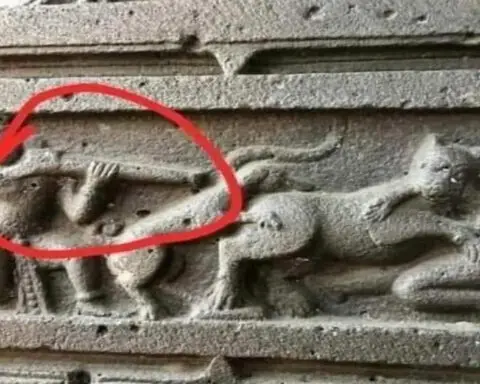Deep within the heart of Nara, Japan, veiled by the enigmatic mists of time, stands the Horyuji Temple, a bastion of serenity and an ancient witness to the passage of countless moons since its foundation in 607 AD. The temple, with its austere wooden architecture, has cradled a mystery in its hallowed halls—a mystery carved in stone, silent yet speaking volumes to those who dare to listen. It is here we find a statue, a sculpted enigma, not of man, nor beast, but of a creature that seems to hail from the forgotten crevices of a primal world—a reptilian entity, seated with folded legs in a posture of tranquil meditation.
This figure, devoid of any human countenance, compels the onlooker to ponder: What cryptic tales could it tell? What arcane knowledge does it guard? In the realm of ancient artifacts, it is not uncommon for the lines between myth and history to blur, for the creators of old to bestow upon their works a life force that transcends the mere representation. The reptilian statue of Horyuji is no mere decorative piece; it is a sentinel of lore, a guardian of the sacred, a conundrum of the spiritual realm.

The temple, erected to manifest the healing powers of the Buddha, is a sanctuary where one can delve into the spiritual depths. It is a place where the physical realm meets the metaphysical, where the echoes of ancient prayers still resonate through the air, as palpable as the cedar scent that permeates the temple grounds. But why, amidst this bastion of Buddhist devotion, does a reptilian statue hold a place of honor? Is it a deity, a demon, a symbol of transformation, or perhaps a forgotten totem of an ancient cult?
One could surmise that this figure is a chimerical amalgam, an embodiment of the complex tapestry of beliefs that Japan held before the arrival of Buddhism. In many cultures, reptilian creatures are revered as symbols of primal power, wisdom, and longevity. Perhaps the statue is a remnant of these indigenous beliefs, subtly integrated into the Buddhist iconography to symbolize the syncretism of old traditions and new faith.
Conversely, some may hypothesize that the statue represents a Naga, a serpent-like being found in various Asian mythologies, known to be protectors of the Dharma in Buddhism. Could this reptilian figure be a Naga, seated in veneration, signifying the protection and spread of Buddhist teachings across the land?

Others, drawn by the threads of more otherworldly explanations, whisper of ley lines, terrestrial energies, and the temple is a nexus for such powers. They speak of the statue as a totem to harness these energies, placed with precise intent, its reptilian form is a conduit for the earth’s raw, healing essence.
In the quietude of Horyuji, the statue sits, its gaze fixed in an eternal state of inward reflection. It neither confirms nor denies the theories and tales woven around it. For those who wander amidst the temple’s age-old pillars, it remains a profound enigma, a portal to a realm where history, mythology, and the cosmic dance of energies merge.
The reptilian figure of Horyuji Temple stands as a silent testament to the enduring human quest for understanding, a reminder that some mysteries, wrapped in the shrouds of ancient times, are not to be unraveled but to be revered in contemplative silence. For now, the reptilian sentinel watches over the temple, a keeper of secrets, beckoning the hearts of the curious to explore the profound depths of the past and the inner landscapes of their being.
VIDEO:






